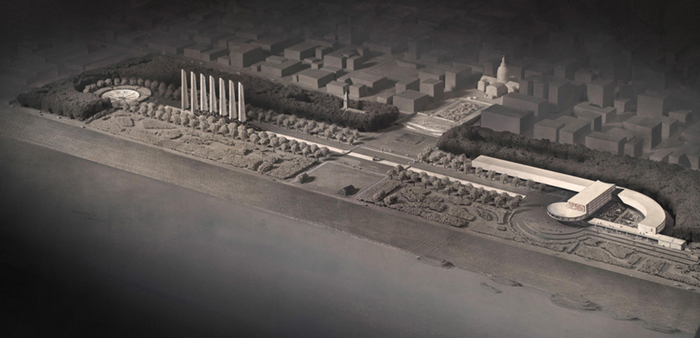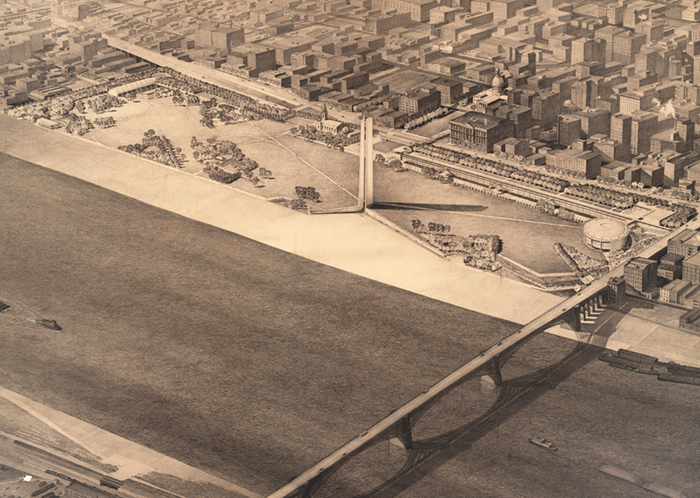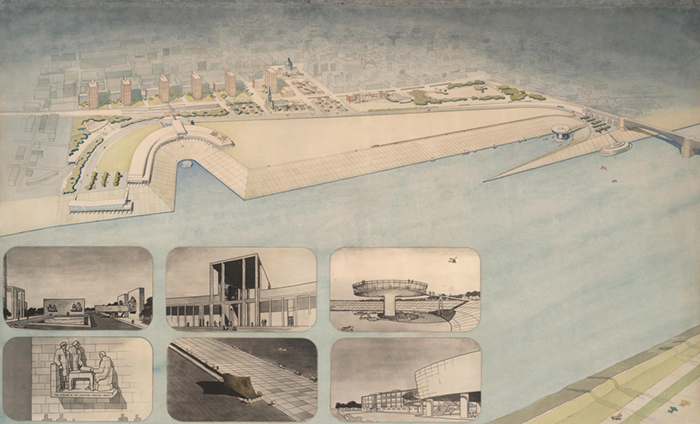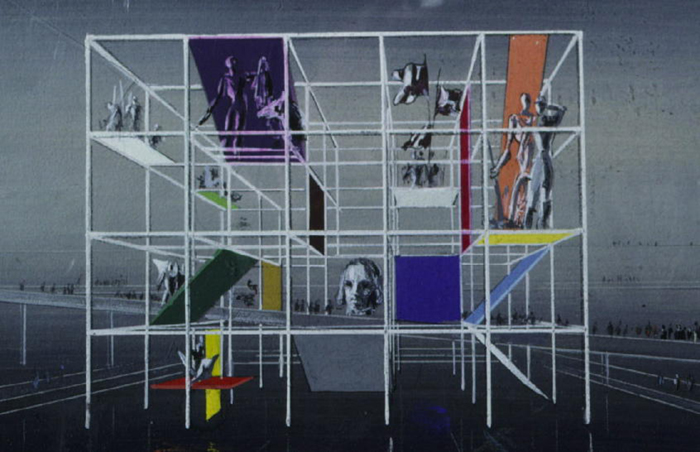This week marks the 50th anniversary of the dedication of the St. Louis Gateway Arch, the architectural masterpiece by Eero Saarinen. Though most St. Louis residents have grown comfortable with this impressive monument as part of our everyday experience, I think I can safely say we do not take it for granted. The 630-foot inverted catenary structure is uniquely St. Louis: it defines us, inspires us, and is the main attraction when sightseeing with visitors.

A 1948 rendering of the Arch by illustrator J. Henderson Barr. Eero Saarinen did not live to see the arch completed as he died in 1961; National Park Service / Jefferson National Expansion Memorial

A 1948 rendering of the Arch by illustrator J. Henderson Barr. Eero Saarinen did not live to see the arch completed as he died in 1961; National Park Service / Jefferson National Expansion Memorial
To stand near it or beneath it is a breathtaking experience. Views of it abound in the city, from all directions, in all weather and light. It never ceases to change, to peek at you from vistas far away, to remind you of something remarkable. The Arch is a testament to man’s ability to dream big. It is a testament to excellence in architectural design, engineering prowess, and hard work by steelworkers who would not take “no” for an answer. Early estimates were that over a dozen workers would be killed in the multi-year construction process. Not one answered that prediction.


A look up at a 630-foot architectural marvel; photograph © John Foster
I have often wondered just where the city of St. Louis might be without this stainless steel superstructure. Not only does it define our city, it is one of the modern marvels of architecture anywhere in the world. It’s journey began with the seed of an idea from one man, Luther Ely Smith, who suggested to then mayor Bernard Dickman that the city needed some type of memorial to “revive the riverfront and stimulate the economy.” I am sure they had no idea what they were getting themselves into. Over the years the idea was nurtured through endless committees and juries, years of planning, and three decades later was dedicated as complete.
The fact that this design was selected from so many other entrants in the 1945–48 Design Competition gives one hope that “committees” do occasionally get it right. Some of the designs that were not selected included giant statues of Thomas Jefferson, westward-bound pioneers, and buffalo. One dubious design included “a restaurant with space for dancing” in a structure extending over the river. Then Washington University architecture professor Paul Valenti suggested and drew plans for a massive bridge over the Mississippi with a subway underneath it. Impressive idea, but not selected.
The competition jury were all established architects: Charles Nagel, director of the Brooklyn Museum who later headed the St. Louis Art Museum; Fiske Kimball, director of the Philadelphia Museum of Art; S. Herbert Hare, a Kansas City landscape architect; William Wurster, dean of architecture at the Massachusetts Institute of Technology; Richard Neutra, who was known for his modernist work in Southern California; Roland Wank, chief architect of the Tennessee Valley Authority; Louis LaBeaume, a St. Louis architect who drafted the competition rules. Howe, the competition adviser, was a prominent Philadelphia architect.
The competition drew 172 entries, including Charles and Ray Eames, Walter Gropius, and even Eero Saarinen’s father Eliel, who was with Cranbrook Institute of Architecture and Design at the time.

Charles Eames, Ray Eames, and John Entenza submitted this entry but it was eliminated in Round 1; National Park Service / Jefferson National Expansion Memorial
The final section was placed at the top and the Arch was completed on October 28, 1965. Join me in celebrating the 50th anniversary of this great American achievement.
Today the Arch grounds is being improved with a new, dramatic “Park Over the Highway” that will, for the first time, allow visitors to walk from the Old Courthouse to the Arch grounds to the riverfront on one continuous greenway, without a curb or stair step in their way.
Read more about this exciting new development at CityArchRiver.
+++

A restaurant and garden featuring animals sculpted by Lily Saarinen (wife of Eero) was included with Saarinen’s original entry; National Park Service / Jefferson National Expansion Memorial

William Eng, Gordon Phillips, and George Foster, graduate students at the University of Illinois, submitted this revised design, which took the second-place prize of $20,000. The design included seven tall pylons and a large museum; National Park Service / Jefferson National Expansion Memorial

William Breger, Caleb Hornbostel, and George Lewis took $10,000 and third place with this entry; National Park Service / Jefferson National Expansion Memorial

This entry by Harris Armstrong made it to Round 2, but he was asked to revise it. Judges thought it looked more impressive from the air than the ground; National Park Service / Jefferson National Expansion Memorial

This revised and completely different entry by Armstrong was a runner up; National Park Service / Jefferson National Expansion Memorial

Walter Gropius, the German architect and founder of the Bauhaus School, submitted this design—which included transparent, open-air frameworks to showcase exhibits. It was rejected; National Park Service / Jefferson National Expansion Memorial

Rejected design by Eliel Saarinen, father of Eero; National Park Service / Jefferson National Expansion Memorial

Detail of monument, part of the overall proposal by Eliel Saarinen; National Park Service / Jefferson National Expansion Memorial

Washington University architecture professor Paul Valenti’s design included an airport and a subway under the river; National Park Service / Jefferson National Expansion Memorial

Rejected entry from Frank Weise, Brewster Adams and Gyo Obata; National Park Service / Jefferson National Expansion Memorial

This rejected entry by Frank Leslie jutted out over the Mississippi and included a restaurant and dance floor; National Park Service / Jefferson National Expansion Memorial

The competition winner Eero Saarinin inspects a model of his arch, one of the greatest architectural achievements of the twentieth century; Yale University Archives

In 1963, the arch was nearing completion; National Park Service / Jefferson National Expansion Memorial

One of the final pieces of the Arch is hoisted into place in 1965; National Park Service / Jefferson National Expansion Memorial

The Arch never ceases to amaze with the changes of light and weather; © John Foster

A view of one leg of the Arch; © John Foster

Some of the best welders in the nation were recruited to attach each three-sided piece of the Arch to one another; © John Foster
